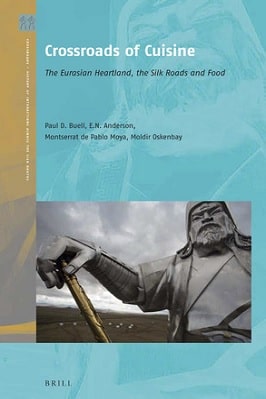
| Book Title | Crossroads Of Cuisine The Eurasian Heartland Pdf |
| Book Author | Paul D. Buell |
| Total Pages | 352 |
| Book Views | |
| Language | English |
| Book Download | PDF Direct Download Link |
| Get Hardcover | Click for Hard Similar Copy from Amazon |
Crossroads of Cuisine – The Eurasian Heartland, the Silk Roads and Food by Paul D. Buell E.N. Anderson Montserrat de Pablo Moya Moldir Oskenbay
CROSSROADS OF CUISINE
Introduction
Central Asia—the Eurasian heartland—has been the crossroads of the Old World since Neanderthals hunted mammoths there. The vast steppes provided a little barrier to travel. Vast mountains and deserts made harder barriers but were not insurmountable.
Wanderers, then migrant herders, then vast caravans of camels and mules travelled the fabled routes that came to be known as the Silk Road, a term coined in 1877 by explorer Ferdinand von Richtofen.1
There were many roads, and silk was only the most famous of countless commodities, but the name conveys the unity and mercantile nature of the routes. Over it came silk from China for the luxury-loving Romans, but also spices, seeds, agricultural ideas, books on food and pharmacy, and other influences on foodways.
Agriculture and herding spread largely from west to east, about as rapidly as they spread through Europe. China contributed little, and that was only late. Central Asia itself gave the world the domesticated horse, and most of the knowledge about how to use it, from riding gear to fermented mare’s milk.
The region became innovative at integrating nomadic and seminomadic stock-raising with settled oasis agriculture. Later, mounted warriors from the heartland rode out to conquer much of the known world.
Central Asia includes the modern nations of Kazakhstan, Turkmenistan, Uzbekistan, Kyrgyzstan, Tajikistan, Afghanistan, and Mongolia. It also includes much of western China: Xinjiang 新疆, and by an extension (“inner Asia” rather than “Central Asia”) Inner Mongolia (Nei Menggu 內蒙古, Öbör Mongol), and Gansu 甘肅 Province west of the Yellow River valley.
The Eurasian heartland blends into China in the west, Tibet in the south, and in the north goes into Russian Siberia. We have generally limited ourselves to this area, but have also followed the trail of Central Asian food to neighbouring Korea and Azerbaijan, to show the great influence of Central Asian cooking there.
We have not been able to follow it farther south and west, for lack of good available materials on Khorasan (northeast Iran) and neighbouring points; our travels in Iran, like the available cookbooks, focused on the Caspian-Tehran-Isfahan corridor.
Within this vast area, larger than the United States, foods are rather similar, the result of a long interaction of human groups and geography. The human record in prehistory and history shaped the available foodstuffs. Geography made some things—such as the herding of livestock—easy and appropriate, other things were difficult, and many things impossible.
No tropical crops survived. Extensive rainfed agriculture was limited to the far northwest and northeast. Steppe, desert and fertile but limited oases shaped foodways. Meat, dairy products, and intensively farmed oasis vegetables and fruit were important.
This book tells the story of food in Central Asia: the natural environment, the coming of agriculture, the domestication of the horse (Central Asia’s great gift to humanity), the rise of cities, the progress of trade. Central Asia has always been the crossroads of Eurasia—a fact far more important in the days of caravan trade than in later centuries when sea trade dominated the world.
Central Asia has had its periods of glory, including the Medieval years when the Mongols controlled the largest contiguous empire the world has ever seen. It also had periods of eclipse, especially when cold dry weather shut down much of its economic activity.
Central Asia is a world of bread, fermented dairy products, grilled and stewed meats, and fruit, often dried. It is a land of noodles and dumplings—wheat made into pastes that serve countless functions.
We chronicle the re-fined cuisines of the great oases, but also the rough but excellent cooking of remote mountain valleys and steppes.
We are a historian and a human ecologist, not chefs or food writers. Thus this book spends considerable time setting the stage—the regional ecology—and telling the back story, the prehistoric and historic development and course of food in the world crossroads.
We follow an early Medieval Arab as he tries to make sense of birch beer, a Russian writer exploring the steppes now in Ka-zakhstan, and the wanderings of Chinese monks seeking Buddhist scriptures in the heartland. We follow archaeologists in examining dumplings from tombs fourteen centuries old. We track caravans over the Silk Routes.
We begin the book with the physical setting, then tell the spread of agricul-ture and stockraising, then recount such of the history as is directly related to foodways. That includes some detail about the nomadic regimes, even when “food” is not directly mentioned, because it was the nomads that carried food-ways for thousands of miles in a few years.
Then we talk of the caravan trade, the early European explorers, and the coming of modernization. Finally we introduce current foodways.
We also present traditional recipes, usually from rare and often personally-published books or from our own experience. We try to present enough of these to give a real flavor of Eurasia’s inner heart.
To read more about the Crossroads Of Cuisine The Eurasian Heartland Pdf book Click the download button below to get it for free
Report broken link
Support this Website
Click here to join our Telegram group for new Books